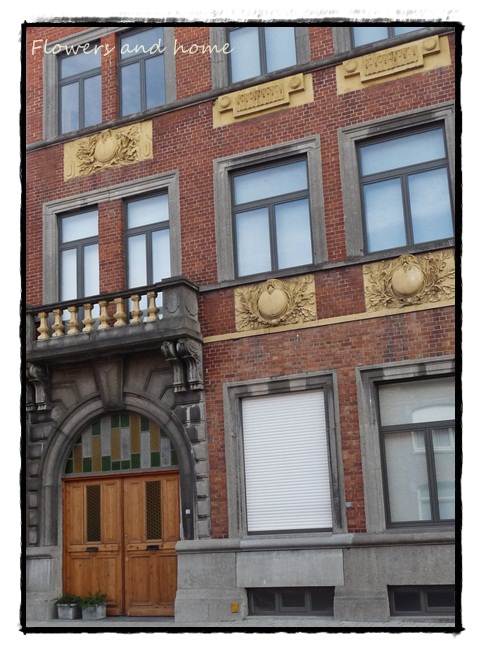I had always wondered about those strange looking houses
a couple of streets from where we live.
They were old but they had features that were a bit too much
I thought, things that didn't quite fit into the whole picture.
I couldn't put my finger on it exactly but there was
something about those houses that kept me curious.
Enkele straten van waar we wonen, staan deze huizen.
Ik vond ze er altijd al een beetje 'anders' uitzien.
Er was iets met deze huizen.
Op de één of andere manier vond ik het plaatje niet echt kloppen
en telkens ik ze zag, bleef ik er me vragen over stellen.
On my walk last saturday, with destination the beautiful
flowers,
I had to pass those houses and decided to put my camera to good use
and photograph them. Back home and looking at the pictures,
I decided to look on the internet later on, to hopefully find out more
about these, out of the ordinary looking, houses.
Tijdens mijn wandeling vorige zaterdag, met als bestemming de mooie bloemen,
kwam ik aan deze huizen voorbij en besloot ik,
nu ik eens mijn fototoestel bij had, de huizen meteen op foto te zetten.
Terug thuis zou ik toch eens opzoeken en hopelijk vinden
wat de geschiedenis achter deze bijzondere huizen wel kon zijn.
And did I find out something. One thing led to another,
as is often the case when you start looking up things
on the internet, and pretty soon everything came together
and I understood how those houses came there
and why they were looking a bit strange.
En wat ik al niet te weten kwam. Het ene leidde tot het andere,
zoals zo vaak als je begint op te zoeken op internet,
en al gauw werd het me duidelijk
hoe de huizen er ooit kwamen
en waarom ze er misschien wat vreemd uitzagen.
It actually all had to do with the first World War
and even the
Old Cemetary is part of the story behind it all.
Het had te maken met de Eerste Wereldoorlog
The houses are on the place where once a 'château', a castle, was.
At the beginning of the first World War, the château was
used as a hospital (hôpital Elisabeth, named after the queen
of Belgium then). It was close to the station and that
was an advantage. Soldiers who didn't make it got buried
in a corner of the garden which is now Old Cemetery.
From what I read about the hospital on the internet,
it was a place the soldiers could call home,
the nurses were volunteers and not army nurses,
they were indulgent and the athmosphere was merciful.
Soldiers called the nurses 'mom' instead of 'nurse'.
Op de plaats waar de huizen nu staan, stond ooit een kasteel.
Vanaf het begin van de Eerste Wereldoorlog werd het kasteel
gebruikt als hospitaal(het Elisabeth Hospitaal, genoemd naar
de koningin van België toen). Het kasteel was vlakbij
het station en dat was een voordeel.
Soldaten die het niet haalden, werden begraven
in een hoek van de kasteeltuin, nu het Old Cemetery.
Van wat ik op het internet las over het hospitaal,
was het een plaats die de soldaten thuis noemden.
De verpleegsters en zusters werkten er vrijwillig.
Ze waren gemoedelijk en de sfeer was ongedwongen.
De soldaten spraken de verpleegsters aan als 'moeder'.
Maria van den Steen de Jehay, who led the hospital, describes it as follows:
Maria van den Steen de Jehay, die het hospitaal leidde, beschreef het als volgt:
L'Hôpital était leur Home.
…
“On est à la maison, ons est chez nous à l'Hôpital. Alors les
Infirmiers, on ne les appellera plus Mademoiselle. On leur dira: Maman.”
Et cela sembla
tout naturel. Et sur les lèvres de ceux qui mouraient le nom de celle qu'on
appelle toujours alors et le nom de celle qui la remplaçait, se confondaient en
un seul mot: Maman.
 |
The castle/hospital at the beginning of the war
Het kasteel/hospitaal aan het begin van de oorlog |
The railroad and the castle were an easy target though
and so, by the end of 1915, the hospital moved to a farm further away.
Several more hospitals were installed in the area but hôpital Elisabeth
kept playing an important role as well, due to its location.
De spoorweg en het kasteel waren een makkelijk doelwit
en tegen het einde van 1915 werd het hospitaal grotendeels verhuisd
naar een boerderij verder weg.
Soldaten die daar overleden werden begraven
Verschillende hospitalen werden opgericht in de omgeving
maar het Elisabeth hospitaal bleef een belangrijke rol spelen
gedurende heel de Eerste Wereldoorlog
vanwege zijn goede ligging.
The castle was bombed many times and by the end of the
first World War, it was totally ruined and uninhabitable.
The remnants of the castle (balconies, bricks, decorations) were used to build houses
on the place where the castle once had been. Those houses are still there now.
Houses with pieces of a former castle built into their façade
would make them look a bit peculiar I guess.
Het kasteel had erg te lijden onder de bombardementen
en was volledig geruïneerd en absoluut onbewoonbaar na de oorlog in 1918.
Het werd dan ook afgebroken, maar het puin werd nuttig besteed.
Waar ooit het kasteel stond, werden huizen gebouwd met in de gevels,
de balkons, versieringen en bakstenen van het kasteel verwerkt.
Die huizen staan er nu nog altijd.
Huizen met in de gevel stukken van een vroeger kasteel verwerkt,
kunnen niet anders dan er een beetje vreemd uitzien, denk ik.
Bye,
Marian
Groetjes,
Marian




















































